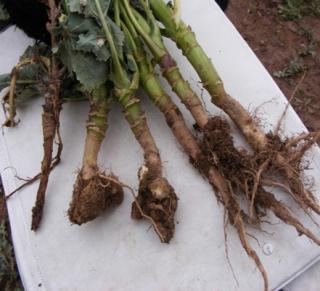Clubroot in Oilseed Rape
Published on 26 September 2011 in Ecosystems and biodiversity , Food, health and wellbeing

Introduction
Short arable rotations and limited crop choices are building soil borne disease problems in oilseed rape crops. Recent work at SRUC (formerly SAC), in collaboration with ADAS, has revealed that half of all oilseed rape fields in Scotland are infected with clubroot.
The galls on roots formed by the clubroot pathogen, Plasmodiophora brassicae, affect normal root function and reduce the uptake of water and nutrients such that even low levels can reduce yield. Large root galls on the taproot will commonly breakdown with secondary rots so that root function is seriously impaired. Plants can be very stunted, lost completely or can wilt in hot dry weather.
The work just completed shows that yield losses can exceed 50%. Clubroot can persist in soils for over 15 years so long rotations are needed to reduce build up in infected fields. Commonly though oilseed rape is grown on short one in three or even one in two rotations as alternative break crops are often unreliable in Scottish growing conditions and provide far poorer economic returns.
Currently oilseed rape prices are high which will increase the area planted. The crop is important to arable enterprises as it is profitable in its own right, but it is also an important break crop for cereals, allowing wheat and barley to positioned at first crops in a rotation where they yield far better than if they follow other cereals.
Key Points
A soil survey with growers and agronomists found that half of fields surveyed were infected with clubroot.
Climate change predictions of warmer autumns suggest this disease burden on crops will increase. Raising soil pH only gave small levels of control, insufficient to mitigate against short rotations which build disease.
Resistant varieties gave better control in trials but this resistance is eroded at sites where it has been used before and where strains of clubroot build up which can over come the major gene resistance involved. Longer rotations are the most sustainable long term method of reducing disease but there will be significant economic losses where that option is followed because of a lack of break crops suitable for Scottish conditions.
Research Undertaken
Clubroot severity is linked to soil pH and crops in acid soils are more at risk of severe symptom development. A three year series of field trials showed that, although the clubroot pathogen is highly resilient and will survive and infect even at high soil pH levels, soil amendments which raised the pH and calcium content of soils could be effective. The work just completed found that liming agents applied just before drilling over the trial series did give modest clubroot control and yield benefits in oilseed rape. Average control was 25%, so while useful this is not enough to mitigate for short rotations. Advise is that liming should be considered as part of a long term strategy for reducing clubroot build up in affected fields when cost benefits over a rotation cycle can be considered.
The resistant oilseed rape varieties Mendel and Cracker offered good control (often greater than 95%) in most areas of the UK and gave more consistent trial results than soil amendments, apart from at sites where they had already been repeatedly used in previous rotations. Trials demonstrated that varietal resistance to clubroot is under pressure in some areas of Scotland, particularly in the north east, and has broken down in areas where it has been commonly used. The two varieties, Mendel and Cracker, share the same resistance mechanism and, in successive crops, strains of clubroot that can overcome the resistance mechanism build up. Over-reliance on resistant varieties in short rotations will increase the risk of build up of these strains and should therefore be avoided.
Lengthening rotations is the most sustainable long-term strategy for managing clubroot, as both soil amendments and varietal control can be inconsistent. Vegetable brassicas are also susceptible so do not act as a break crop. Cruciferous weeds will also carry infection and reduce the benefits of true break crops like cereals, potatoes or legumes. Rotations of longer than one year in five are likely to be helpful. Annual crop choices are often driven by commodity pricing but growers should think longer term about plans for fields and balance the benefits of longer rotations in infected fields against short rotations with high yield losses.
Policy Implications
Short rotations and limited crop choices illustrate how vulnerable Scottish arable production could be to changes in climate and disease burden.
Areas of particular weakness should be assessed in research programmes. Alternative crops offer a chance to widen rotations and reduce disease burdens.
Economic assessments of impacts should consider benefits across whole rotations or longer term, rather than single season benefits.
Author
Dr Fiona Burnett Fiona.Burnett@sruc.ac.uk
Topics
Ecosystems and biodiversity , Food, health and wellbeing







